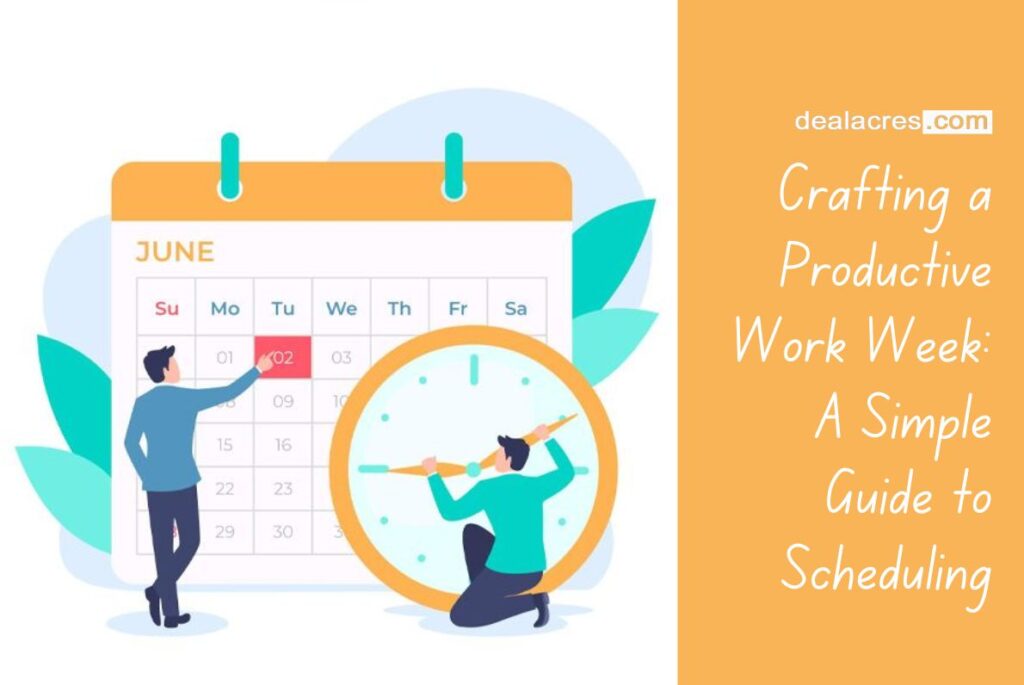Introduction:
Welcome to a guide on making your work week smooth and successful! Think of it as crafting a roadmap for your success. We’ll take you through simple steps to plan your work week effectively. Whether it’s figuring out what’s most important or making sure you have time for breaks, we’ve got practical tips to help you make the most of your time and reach your goals. So, let’s dive in and make your work week work for you!

Step 1: Set Clear Goals and Priorities:
Start your week by outlining your goals. What do you want to achieve by the end of the week? Whether it’s work-related tasks, personal projects, or self-care goals, clarity is key. Prioritize these goals based on importance and deadlines.
Step 2: Create a Weekly Overview:
Once you have your goals in mind, create a weekly overview. Break down your week into days and allocate specific tasks to each day. Consider your energy levels and the time required for each task. Be realistic about what you can accomplish in a day.
Step 3: Utilize Time Blocking:
Time blocking involves dedicating specific blocks of time to particular tasks. This helps in maintaining focus and avoiding multitasking. Assign time blocks for different activities, such as work tasks, meetings, and personal commitments. Stick to these blocks as closely as possible.
Step 4: Prioritize the Most Important Tasks (MITs):
Identify the Most Important Tasks (MITs) for each day. These are the tasks that, when accomplished, contribute significantly to your goals. Tackling your MITs early in the day ensures that you make progress toward your overarching objectives.
Step 5: Factor in Breaks and Rest:
Don’t forget to include breaks in your schedule. Taking short breaks between tasks can refresh your mind and improve overall productivity. Additionally, schedule longer breaks for meals and relaxation to maintain a healthy work-life balance.
Step 6: Flexibility for Unplanned Tasks:
While planning is essential, leave room for the unexpected. There might be last-minute tasks or urgent matters that require your attention. Having a bit of flexibility in your schedule allows you to handle these unforeseen circumstances without feeling overwhelmed.

Step 7: Allocate Specific Times for Emails and Communication:
Designate specific times for checking emails and responding to messages. Constantly attending to emails throughout the day can be distracting. By allocating dedicated times for communication, you can manage your inbox more efficiently.
Step 8: Theme Your Days:
Think of your work week like a well-organized plan. Instead of doing a bit of everything every day, consider giving each day a theme. For example, make Mondays your planning day, where you focus on organizing and getting administrative tasks done. Wednesdays can be your creative day, dedicated to imaginative and innovative work. Lastly, reserve Fridays for tying up loose ends and finishing up anything outstanding.
Why theme your days? It’s like giving each day a special job, making your schedule easier to handle. When you know what to expect on each day, it’s simpler to stay on track. You’re not trying to do everything all at once, and it helps you manage your time more smoothly.
On your planning day, get all your ducks in a row. Organize your schedule, set goals for the week, and handle any administrative tasks on your to-do list. This sets the tone for a well-organized week.
When Wednesday rolls around, let your creative side shine. Use this day to work on projects that require thinking outside the box. By dedicating a whole day to creativity, you can dive deep into your imaginative work without distractions.
As the week winds down, shift your focus to wrapping things up on Fridays. Finish any tasks still lingering, tie up loose ends, and make sure everything is in order. It’s like putting a neat bow on your week, so you can start the next one with a fresh perspective.
Theming your days isn’t about making things rigid; it’s about creating a structure that works for you. You can always adjust as needed, but having a basic plan in place helps you approach your work week with more ease and confidence. So, give it a try and see how having themed days can make your schedule more manageable and enjoyable.
Step 9: End-of-Day Reflection:
Before wrapping up each day, take a few minutes for reflection. Review what you accomplished, what didn’t get done, and why. This reflection time allows you to adjust your approach for the next day and identify any recurring challenges.
Step 10: Stay Mindful of Energy Levels:
Pay attention to your energy levels throughout the day. Schedule tasks that require high focus and creativity during your peak energy periods. Save routine or less demanding tasks for times when your energy naturally dips.

Step 11: Plan Personal and Self-Care Activities:
Incorporate personal and self-care activities into your schedule. Whether it’s spending time with family, exercising, or pursuing hobbies, scheduling these activities ensures you prioritize your overall well-being.
Step 12: Weekly Review and Adjustment:
As the week comes to an end, take a little time to look back and see how things went. Think about what went well and what you think could be better. This is like giving yourself a report card for the week.
Ask yourself questions like, “Did I get my important tasks done?” or “Was there something that made my week stressful?” By doing this, you can figure out what worked and what didn’t.
The cool part is that you get to make changes based on what you learn. If something was a success, you can keep doing it. If there’s a way to make things smoother or less stressful, you can come up with a plan to do that next time.
This process isn’t about being hard on yourself; it’s about getting better each week. It’s like practicing a sport – you review how you played, figure out where you can improve, and then go into the next game with a plan to do better.
Maybe you notice that certain tasks are better done at a specific time, or you realize you need more breaks during the day. By making small adjustments each week, you’re building a schedule that suits you best.
So, the weekly review is your chance to reflect, learn, and make your upcoming weeks even better. It’s like having a little coach inside you, helping you refine your game plan for the next round. Keep it simple, be kind to yourself, and use what you learn to keep improving week by week.
Conclusion:
In wrapping up, making your work week productive is like finding the right mix that suits you. When you set clear goals, use simple time-blocking methods, and stay open to changes, you can make a schedule that makes your work easier and keeps you feeling good. It’s not just about being busy; it’s about having a plan for how you spend your time. By following these easy strategies, you can plan your work week with purpose and get the results you want. So, go ahead, try these tips, and make your work week work for you!




